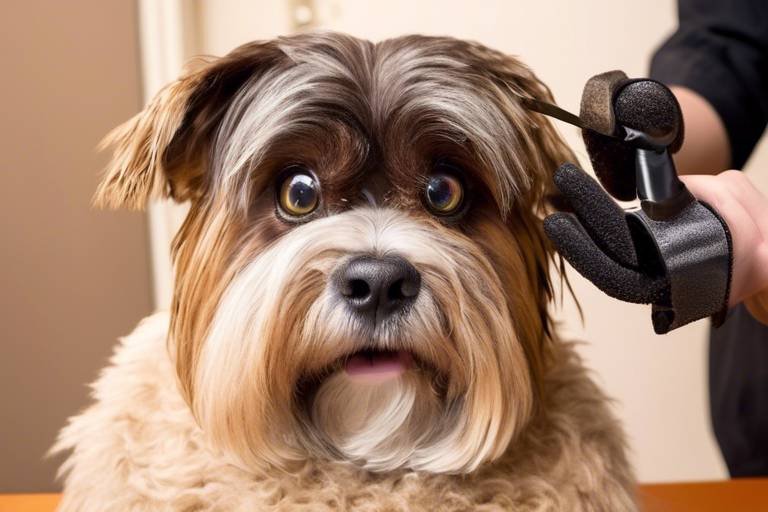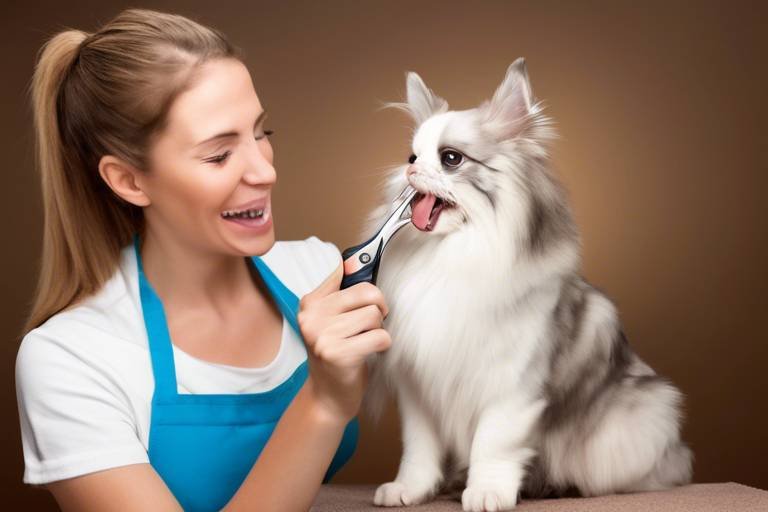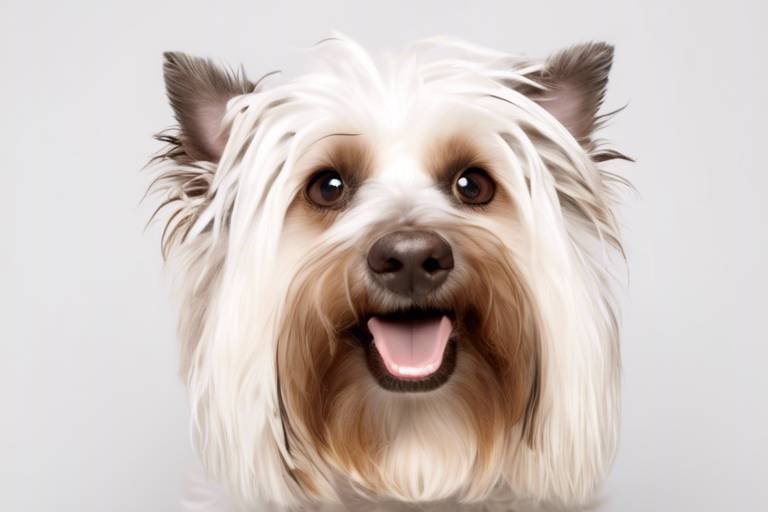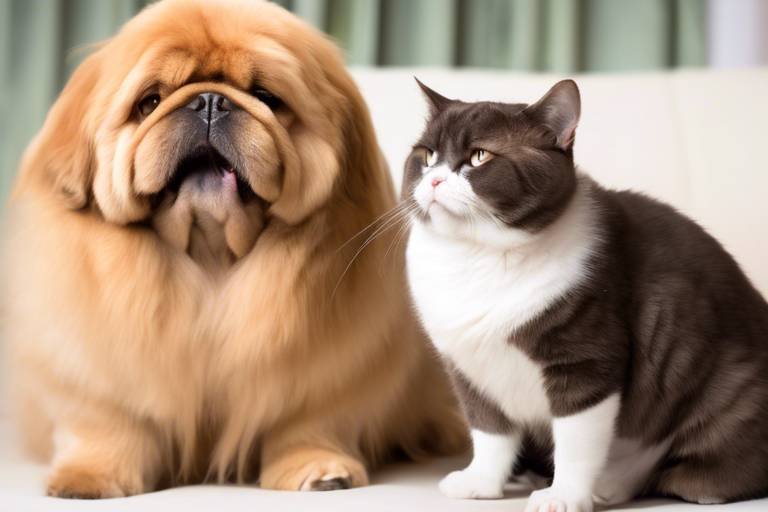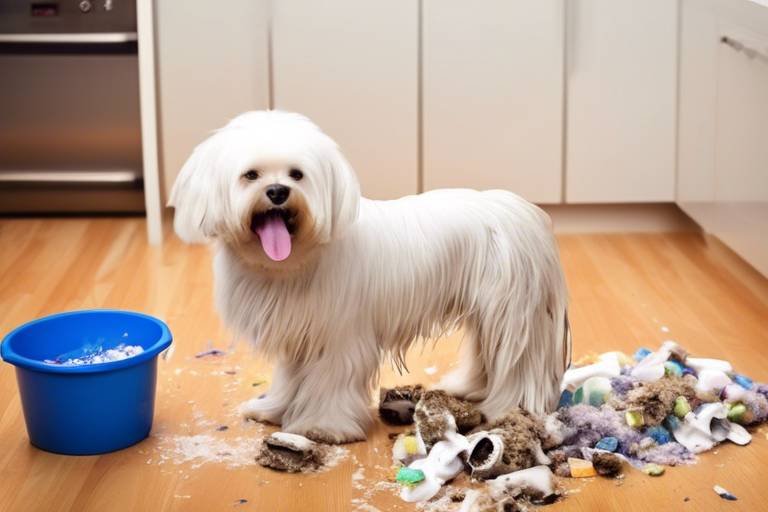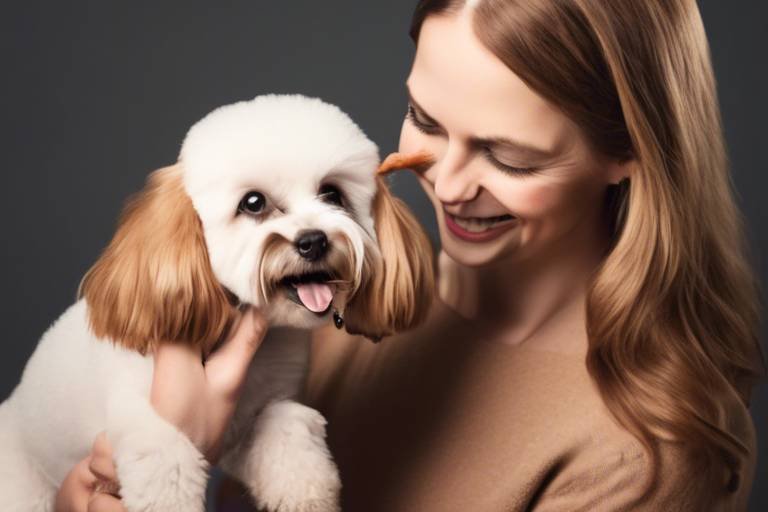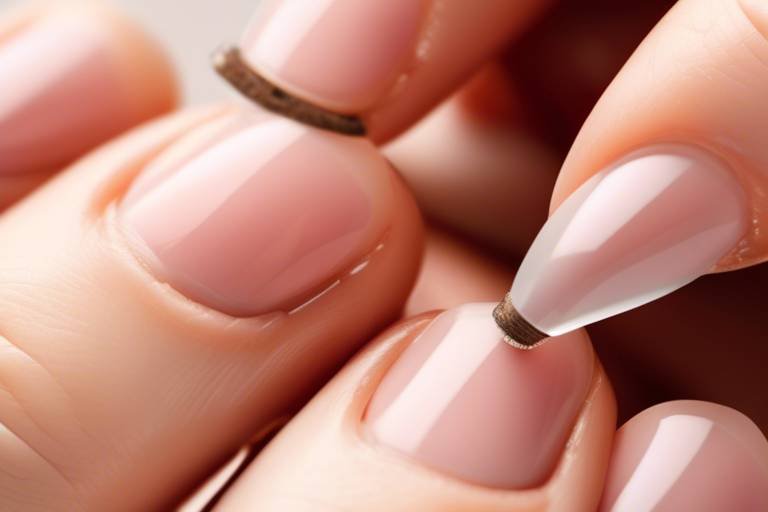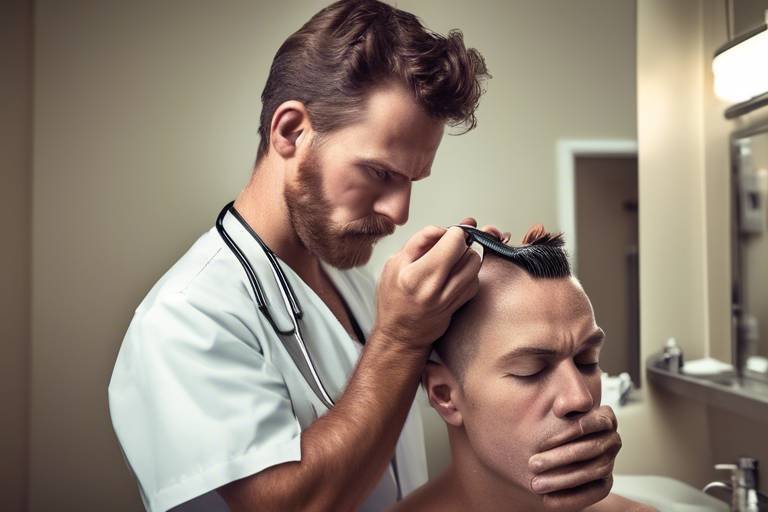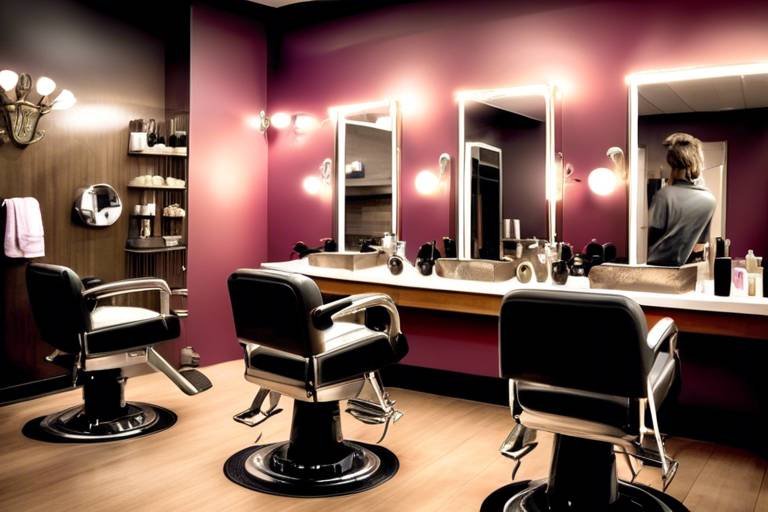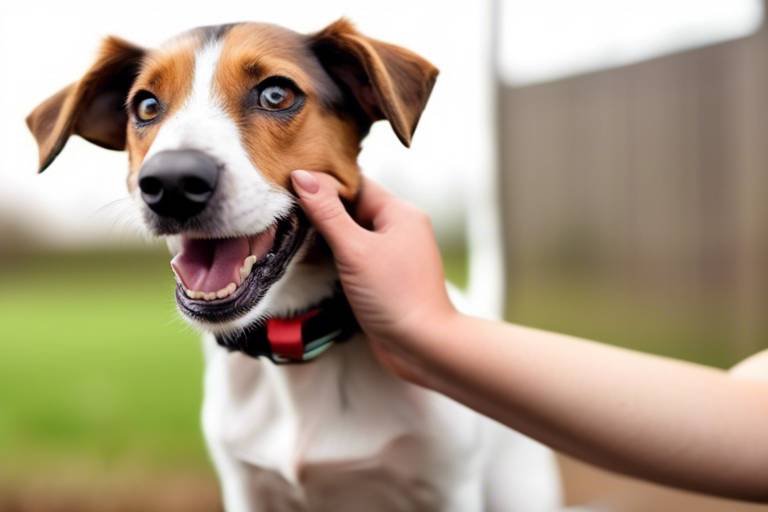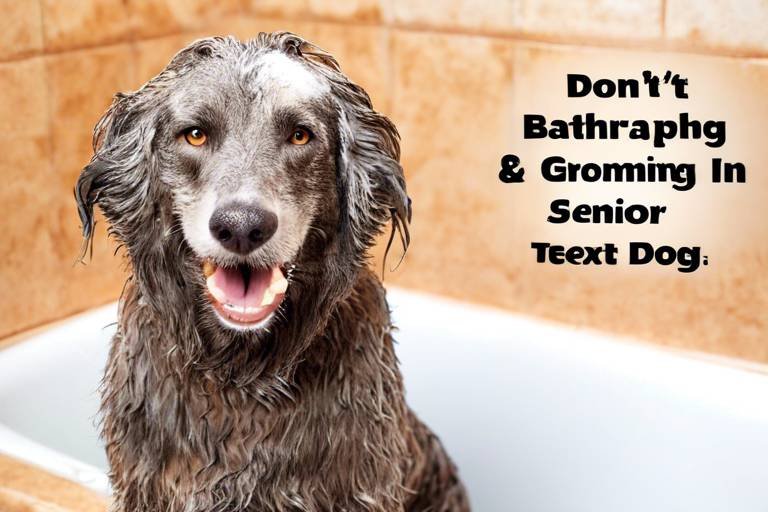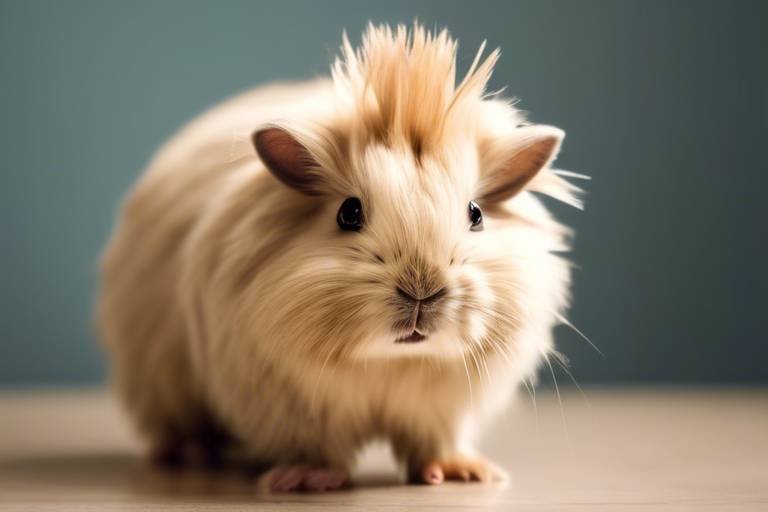The Importance of Regular Grooming for Therapy Pets
Have you ever thought about the **unsung heroes** in the world of therapy? Yes, we're talking about therapy pets! These incredible animals play a crucial role in providing comfort and healing to those in need. But here's the kicker: just like any other pet, therapy animals require **regular grooming** to ensure they remain healthy, happy, and effective in their roles. Grooming is not merely a cosmetic endeavor; it is a fundamental aspect of their care that directly impacts their health, behavior, and overall effectiveness in therapeutic settings.
When we think about grooming, we often picture brushing fur or trimming nails. However, the significance of grooming extends far beyond aesthetics. Regular grooming routines can help prevent a myriad of health issues, including skin infections, parasites, and even stress-related problems. Picture this: a therapy dog with matted fur or a cat with unkempt claws may not only feel uncomfortable but may also be less inclined to engage positively with clients. This is why establishing a consistent grooming schedule is essential for these remarkable animals.
Moreover, grooming can be a bonding experience between the therapy pet and their handler. Just imagine the trust that develops when a pet is gently brushed and cared for. It’s a bit like a spa day for your furry friend! This trust is vital for the effectiveness of therapy sessions, as it allows animals to feel secure and confident in their surroundings. As handlers, we have the responsibility to ensure that our therapy pets are not only well-groomed but also emotionally supported during the grooming process. After all, a happy pet is a more effective therapy pet!
In this article, we will delve deeper into the various aspects of grooming therapy pets, including the health benefits, behavioral improvements, and essential grooming tools. We'll also explore some practical DIY grooming tips to help you maintain your pet's grooming routine at home. So, whether you are a seasoned handler or a pet owner looking to support your therapy pet, this guide will provide you with valuable insights into the world of grooming.
Regular grooming is not just about keeping your therapy pet looking good; it is a **critical component** of their overall health. Grooming helps in:
- Preventing skin issues: Regular brushing removes dirt and debris, preventing skin irritations and infections.
- Reducing parasites: Grooming sessions can help identify and eliminate fleas, ticks, and other parasites before they become a problem.
- Promoting better circulation: The act of brushing stimulates the skin and improves blood flow, which is essential for healthy skin and coat.
When therapy pets are healthy, they are more likely to perform their roles effectively, ensuring that they can provide the best support to those they serve.
Grooming can significantly influence a therapy pet's behavior. Just think about it: when a pet feels clean and comfortable, they are more likely to be relaxed and approachable. Routine grooming fosters trust and reduces anxiety, creating a positive environment for both the pet and the clients they interact with. This is particularly important when therapy pets work with individuals who may already be experiencing stress or anxiety.
Establishing a grooming routine is more than just a practical task; it’s an opportunity to build a strong bond of trust between the therapy pet and their handler. When pets associate grooming with positive experiences, they feel more secure and confident in their environment. This trust is crucial for effective therapy, as it encourages pets to engage more openly with clients, enhancing the therapeutic experience.
Using gentle grooming techniques can enhance the bonding experience between the pet and handler. Here are a few techniques to ensure a stress-free grooming session:
- Start slowly and allow the pet to acclimate to the grooming tools.
- Use soft brushes and tools designed for sensitive skin.
- Incorporate treats and praise to create a positive association with grooming.
Understanding a therapy pet's stress signals during grooming is essential for their well-being. Key indicators that a pet may be uncomfortable include:
- Whining or barking
- Tensing up or pulling away
- Excessive licking or grooming of themselves
Being attuned to these signals allows handlers to adjust their approach, ensuring a more positive grooming experience.
Well-groomed therapy pets tend to have better interactions with clients. A clean, well-cared-for pet is more likely to be perceived as friendly and approachable, which can enhance the overall therapeutic experience. Clients may feel more comfortable interacting with a pet that looks healthy and well-groomed, leading to more effective therapy sessions.
Choosing the right grooming tools is crucial for effective grooming. Here’s a quick overview of essential grooming tools:
| Tool | Purpose |
|---|---|
| Brush | Removes loose fur and dirt |
| Comb | Detangles fur and checks for parasites |
| Clippers | Trims fur and nails |
Understanding these tools helps ensure proper care for therapy pets, making grooming a more effective and enjoyable experience.
In addition to the basic tools, there are specialized grooming tools designed for specific breeds or coat types. Knowing which tools to use can make a significant difference in the grooming process. For example, a slicker brush is excellent for removing mats in long-haired pets, while a rubber curry brush can be effective for short-haired breeds.
If you prefer to groom your therapy pet at home, here are some practical DIY tips:
- Establish a regular grooming schedule to keep your pet comfortable and clean.
- Keep grooming sessions short and positive to prevent stress.
- Always reward your pet after grooming to build a positive association.
Q: How often should I groom my therapy pet?
A: It depends on the breed and coat type, but generally, regular grooming every 4-6 weeks is recommended.
Q: Can I groom my therapy pet at home?
A: Yes! With the right tools and techniques, you can maintain a grooming routine at home.
Q: What should I do if my pet shows signs of stress during grooming?
A: Take a break, assess the situation, and try to ease their anxiety with gentle handling and rewards.
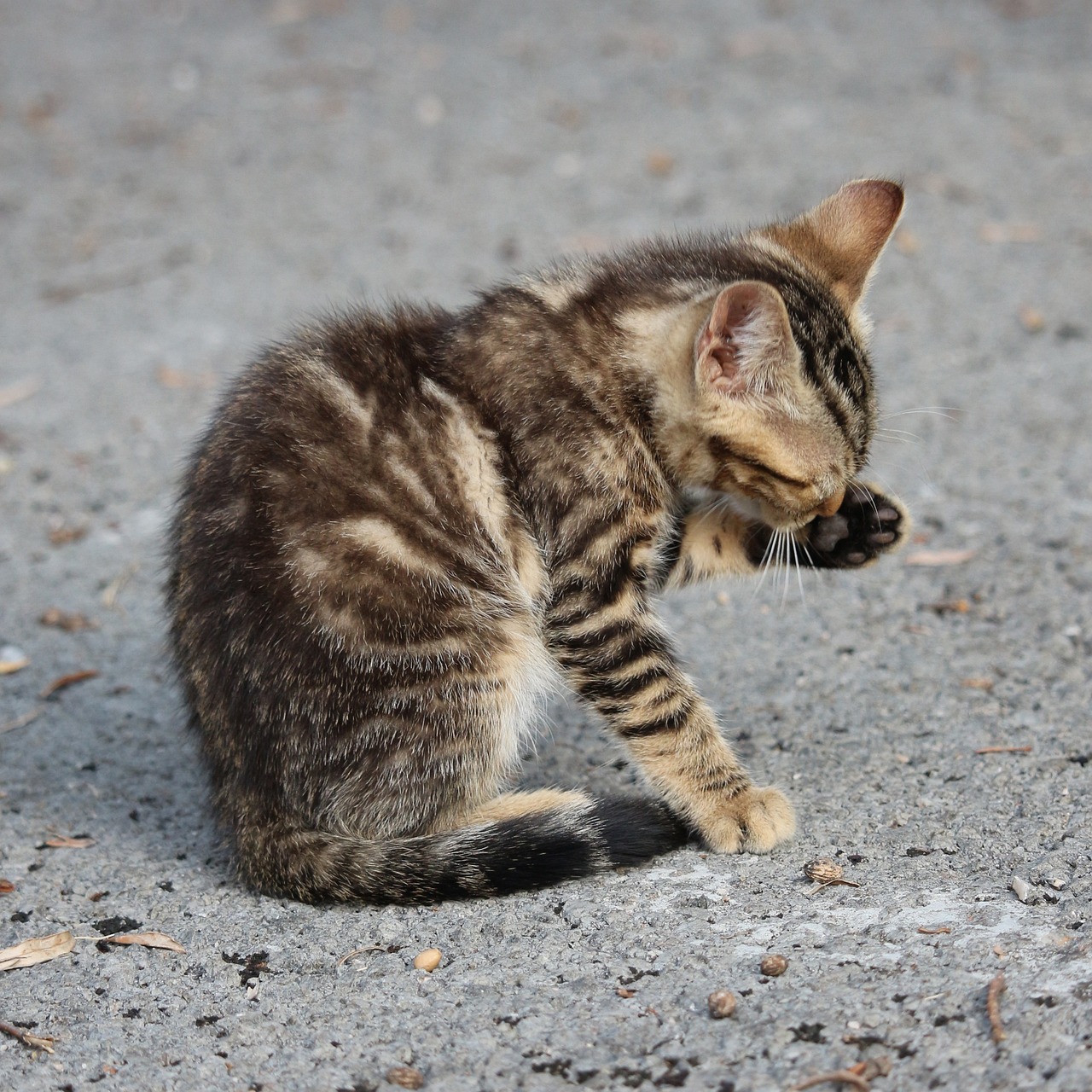
Health Benefits of Grooming
When it comes to therapy pets, grooming is not just about looking good; it’s a critical component of their overall health and well-being. Regular grooming sessions can significantly enhance a therapy pet's physical condition and ensure they are always ready to perform their vital roles. Think of grooming as a health check-up that you can do at home! It’s like giving your furry friend a mini spa day while also keeping an eye on their health.
One of the most significant benefits of grooming is the prevention of skin issues. Just like humans, pets can suffer from a variety of skin conditions, including allergies, infections, and irritations. Regular brushing helps remove dirt, debris, and loose fur, which can otherwise accumulate and lead to skin problems. By keeping their coat clean and free of tangles, you're not just making them look pretty; you're actively preventing potential health issues.
Moreover, grooming plays a crucial role in reducing the presence of parasites. Fleas, ticks, and other pests can be a major concern for therapy pets, especially since they often interact closely with people. Regular grooming sessions allow handlers to spot these unwanted guests early on, which can prevent infestations that could harm both the pet and the clients they serve. It's like a health shield that protects them from external threats!
Additionally, grooming promotes better circulation. When you brush your therapy pet’s coat, you’re not just removing loose hair; you’re also stimulating the skin and improving blood flow. This enhanced circulation can lead to healthier skin and coat, making your pet feel more energetic and vibrant. Just imagine how much better you feel after a nice massage – it’s the same for them!
To summarize, here are some key health benefits of regular grooming:
- Prevention of skin issues: Regular grooming helps avoid allergies and infections.
- Reduction of parasites: Early detection of fleas and ticks keeps pets healthy.
- Improved circulation: Brushing stimulates skin health and energy levels.
In conclusion, the health benefits of grooming extend far beyond aesthetics. It's an essential practice that prepares therapy pets for their important roles, ensuring they remain healthy, happy, and ready to provide comfort and support to those in need. So, the next time you pick up that brush, remember that you’re doing more than just grooming; you’re investing in your pet’s health and well-being!

Behavioral Improvements
When it comes to therapy pets, grooming is not just about looking good; it's a crucial aspect of their overall behavior and well-being. Regular grooming can have a transformative effect on a therapy animal's demeanor. Imagine a dog or cat that feels clean, comfortable, and cared for—this state of being can lead to a more relaxed and engaging pet. When therapy animals are groomed regularly, they are less likely to exhibit signs of stress or anxiety, which can significantly enhance their ability to connect with clients.
Grooming sessions can serve as a form of bonding time between the pet and their handler. This bond is essential for effective therapy work, as it fosters a sense of trust and security. A therapy pet that trusts its handler is more likely to be calm and responsive during therapy sessions. Think of it like this: just as a well-tuned musical instrument produces beautiful melodies, a well-groomed therapy pet is more likely to resonate positively with those they serve.
Additionally, a consistent grooming routine can help reduce behavioral issues that stem from discomfort or anxiety. For example, if a pet is constantly scratching due to matting or skin irritations, their focus will be on their discomfort rather than on engaging with clients. Regular grooming addresses these issues head-on, allowing the pet to be more present and interactive. This leads to a more fulfilling experience for both the pet and the clients they serve.
But how does grooming specifically influence behavior? Here are a few key points:
- Relaxation: The act of grooming can be soothing for pets, helping to calm their nerves and reduce anxiety levels.
- Increased Confidence: A clean and well-groomed pet is likely to feel more confident, which translates into better interactions with clients.
- Trust Building: Regular grooming sessions create a routine that pets can rely on, fostering trust between them and their handlers.
Moreover, the positive effects of grooming extend beyond the individual pet. When therapy animals are calm and well-behaved, it creates a more positive atmosphere during therapy sessions. Clients often respond better to animals that are relaxed and confident, leading to more effective therapeutic interactions. In essence, grooming not only benefits the therapy pets themselves but also enhances the overall therapeutic experience for clients.
In conclusion, regular grooming is a vital practice that yields numerous behavioral improvements in therapy pets. By investing time in grooming, handlers can ensure their pets are not only healthy but also emotionally equipped to perform their essential roles. So, next time you think about grooming, remember—the benefits are far-reaching, impacting both the pet and the people they help.
Q1: How often should therapy pets be groomed?
A1: It depends on the breed and coat type, but generally, therapy pets should be groomed at least once a month, with more frequent grooming for long-haired breeds.
Q2: What are the signs that my therapy pet needs grooming?
A2: Look for matting in the fur, excessive shedding, skin irritations, or an overall unkempt appearance. If your pet seems uncomfortable or anxious, it might be time for a grooming session.
Q3: Can grooming help with my pet's anxiety?
A3: Yes! Regular grooming can provide a sense of routine and comfort, helping to alleviate anxiety and improve your pet's behavior.
Building Trust Through Grooming
When it comes to therapy pets, establishing a bond of trust is paramount. Just like humans, animals thrive on relationships built on trust and comfort. Regular grooming sessions can serve as a wonderful opportunity to foster this bond. Imagine a gentle hand brushing through your hair; it feels good, right? Now, think about how your therapy pet feels during grooming. It’s not just about keeping them clean; it’s about creating a safe space where they can relax and feel secure.
During these grooming sessions, the pet learns to associate the experience with positive feelings. The act of brushing, bathing, or simply petting can release endorphins in the animal, making them feel happy and relaxed. This is especially important for therapy pets, as their job often involves interacting with individuals who may be anxious or in distress. A calm and relaxed therapy pet can make all the difference in a therapeutic setting.
Moreover, trust is a two-way street. As handlers take the time to groom their therapy pets, they also learn to read the animal's body language. This mutual understanding enhances the relationship, as both parties become more attuned to each other's needs. For instance, if a pet shows signs of discomfort during grooming, the handler can adjust their approach, thus reinforcing the pet's trust in them. This creates a cycle of trust, where the pet feels safe to express their needs, and the handler is responsive to those cues.
To build this trust effectively, consider incorporating the following gentle grooming techniques:
- Start Slowly: Begin with short grooming sessions to help the pet get used to the process.
- Use Positive Reinforcement: Reward your therapy pet with treats or praise during and after grooming to create a positive association.
- Be Patient: Allow the pet to explore the grooming tools at their own pace. This can alleviate any fears they may have.
In essence, grooming is more than just a routine; it’s a powerful tool for building a trusting relationship between therapy pets and their handlers. By investing time in grooming, you’re not only ensuring your pet’s physical well-being but also enhancing their emotional health. This bond ultimately leads to more effective therapy sessions, as the pet feels secure and confident in their role.
Q1: How often should I groom my therapy pet?
A1: The frequency of grooming depends on the breed and coat type. Generally, therapy pets should be groomed at least once a week to maintain their coat and health.
Q2: What if my therapy pet resists grooming?
A2: If your pet shows resistance, take a step back. Use treats and positive reinforcement to create a positive association with grooming. Gradually increase the time spent grooming as they become more comfortable.
Q3: Are there specific tools I should use for grooming?
A3: Yes, the right tools depend on your pet's coat type. Brushes, combs, and clippers designed for their specific needs will help ensure a comfortable grooming experience.
Q4: Can grooming help with anxiety in therapy pets?
A4: Absolutely! Regular grooming can significantly reduce anxiety levels in therapy pets, making them more relaxed and effective in their roles.
Techniques for Gentle Grooming
When it comes to grooming therapy pets, the key is to prioritize gentleness and patience. These animals play a crucial role in providing comfort and support to those in need, so their grooming sessions should be as calming and stress-free as possible. Here are some techniques that can enhance the grooming experience for both the pet and the handler.
First and foremost, it's essential to create a calm environment. Choose a quiet space where the therapy pet feels safe and comfortable. Soft lighting and soothing music can help set the mood, making the grooming process feel less like a chore and more like a bonding activity. This environment not only helps the pet relax but also enables the handler to focus on the grooming without distractions.
Next, start with gentle brushing. Use a soft-bristled brush or a comb designed for the specific coat type of the therapy pet. Begin brushing in the direction of hair growth, using light strokes to avoid pulling or tugging at the skin. This gentle approach not only removes loose fur and debris but also stimulates the skin, promoting healthy circulation. If the pet has any tangles or mats, work on them slowly, using your fingers to separate the hair before applying the brush.
Another effective technique is to incorporate positive reinforcement. Use treats or praise to reward the pet for their cooperation during grooming. This not only makes the experience more enjoyable for the animal but also helps them associate grooming with positive outcomes. Over time, this can lead to a more relaxed and trusting pet, which is essential for their role as a therapy animal.
Additionally, consider introducing grooming tools gradually. If your therapy pet is new to grooming, allow them to sniff and explore the tools before using them. This can help reduce any anxiety they might have about the process. Once they are comfortable, you can begin using the tools, always observing their reactions and adjusting your approach as needed.
Finally, be attentive to the pet's body language. Signs of discomfort, such as tensing up or trying to escape, indicate that the grooming session may need to be paused or adjusted. If a pet seems particularly anxious, it might be helpful to take a break and allow them some time to relax before continuing. Understanding their signals is crucial for building trust and ensuring a positive grooming experience.
In summary, gentle grooming techniques are all about creating a positive, stress-free environment that encourages trust and comfort. By focusing on the pet's needs and being attentive to their reactions, handlers can foster a strong bond that enhances the overall therapeutic experience.
- How often should therapy pets be groomed? - It depends on the breed and coat type, but regular grooming every 4-6 weeks is generally recommended.
- What tools are best for grooming therapy pets? - Essential tools include brushes, combs, and nail clippers. Choose tools based on the pet's specific grooming needs.
- Can I groom my therapy pet at home? - Yes! With the right tools and techniques, home grooming can be effective and rewarding.
- What should I do if my therapy pet shows signs of stress during grooming? - Take a break, reassess your approach, and consider using positive reinforcement to help them relax.
Recognizing Stress Signals
Understanding and recognizing stress signals in therapy pets is crucial for their well-being and the effectiveness of their therapeutic roles. Just like humans, animals can experience stress, and it’s vital for handlers to be attuned to their furry companions' emotional states. When a therapy pet feels anxious or uncomfortable, it can impact their interactions with clients and their overall performance. So, how can you tell when your therapy pet is feeling stressed?
First, observe their body language. Animals communicate a lot through their posture and movements. For instance, a tense body or a tail that is tucked between their legs can indicate discomfort. Additionally, ear position plays a significant role; ears that are pinned back or flicking rapidly can signal anxiety. It's essential to be aware of these subtle cues because they can help you identify when your pet needs a break or a change in approach.
Another important aspect to consider is vocalization. If your therapy pet starts whining, growling, or barking excessively, it might be their way of expressing discomfort or distress. These sounds can serve as a warning that they are not in a relaxed state and may need your attention. Furthermore, you should pay attention to their breathing patterns. Rapid or shallow breathing can be a sign of stress, indicating that your pet is feeling overwhelmed.
Some common stress signals to look out for include:
- Yawning - While it can be a sign of sleepiness, excessive yawning can indicate stress.
- Excessive licking - This behavior can be a coping mechanism for stress.
- Withdrawal - If your pet is trying to hide or move away from the situation, they may be feeling anxious.
Being proactive in recognizing these signals allows handlers to adjust their grooming techniques or take a step back when necessary. For example, if a pet shows signs of stress during grooming, it may be beneficial to take a break, offer some gentle reassurance, or even engage them in a calming activity. By fostering a supportive environment, you can help your therapy pet feel more secure and relaxed, which ultimately enhances their ability to provide comfort to clients.
In conclusion, recognizing stress signals in therapy pets is not just about ensuring their comfort; it’s about enhancing the overall therapeutic experience for everyone involved. By being vigilant and responsive to your pet's needs, you can create a more effective and enjoyable environment for both the animal and the clients they serve.
Q1: What are some common signs of stress in therapy pets?
A1: Common signs include tense body posture, pinned-back ears, excessive vocalization, rapid breathing, and withdrawal behavior.
Q2: How can I help my therapy pet when they show signs of stress?
A2: You can help by taking breaks during grooming, providing gentle reassurance, and engaging them in calming activities.
Q3: Is it normal for therapy pets to experience stress?
A3: Yes, it's normal for therapy pets to experience stress, just like humans. Being aware of their stress signals can help you manage their well-being effectively.
Grooming and Client Interaction
When it comes to therapy pets, grooming is not just about aesthetics; it's about enhancing the entire therapeutic experience. Well-groomed therapy animals tend to exhibit better interactions with clients, and this can significantly impact the effectiveness of therapy sessions. Imagine walking into a room filled with anxiety and uncertainty, and then being greeted by a clean, well-groomed pet. It’s like a breath of fresh air! The visual appeal and the pleasant smell of a freshly groomed animal can instantly create a welcoming atmosphere.
Moreover, the way a therapy pet presents itself can influence a client's perception. A shaggy, unkempt pet might unintentionally evoke feelings of discomfort or unease, while a well-groomed animal radiates confidence and approachability. This transformation can lead to increased engagement from clients, allowing them to open up more freely during sessions. The bond between the client and the therapy pet is crucial, and grooming plays a key role in fostering that connection.
Additionally, grooming helps in maintaining the pet’s physical health, which translates to improved energy and enthusiasm during client interactions. A therapy pet that feels good in its own skin is more likely to be playful, affectionate, and responsive. This positive demeanor can make all the difference when it comes to encouraging clients to interact and engage. For instance, a dog that feels comfortable and relaxed is more likely to approach a client for a cuddle or a game, creating a more interactive and enriching experience.
It's also essential to note how grooming can mitigate any behavioral issues that might arise during therapy sessions. If a pet is uncomfortable due to matted fur or skin irritations, it may become irritable or withdrawn. Regular grooming helps prevent these issues, ensuring that therapy pets remain calm and ready to provide the support their clients need. In turn, this leads to a more productive therapeutic environment where clients can feel safe and supported.
In summary, the relationship between grooming and client interaction in therapy settings is profound. The act of grooming not only enhances the physical appearance of therapy pets but also boosts their emotional well-being, which in turn fosters stronger connections with clients. A well-groomed therapy animal is a beacon of positivity, inviting clients to engage, explore, and heal. As we continue to understand the critical role that grooming plays, it's clear that it should be an integral part of any therapy pet's routine.
- How often should therapy pets be groomed? - It depends on the breed and coat type, but generally, regular grooming every 4-6 weeks is recommended.
- Can grooming help with a therapy pet's anxiety? - Yes, routine grooming can create a sense of security and calmness for therapy pets.
- What are the signs that a therapy pet needs grooming? - Look for matted fur, excessive shedding, or skin irritations as indicators for grooming.
- Are there specific grooming techniques for therapy pets? - Gentle brushing, regular baths, and nail trimming are essential techniques to ensure comfort and cleanliness.

Grooming Tools and Techniques
When it comes to grooming therapy pets, having the right tools and techniques can make a world of difference. Just like a painter needs quality brushes to create a masterpiece, a handler needs effective grooming tools to maintain the health and appearance of their beloved therapy animals. These tools not only help keep the pets looking their best but also play a crucial role in their overall well-being. For instance, using a high-quality brush can help remove loose fur and dirt, while also promoting healthy skin by stimulating circulation. The right grooming tools can transform a simple grooming session into a bonding experience that strengthens the relationship between the pet and handler.
One of the most essential grooming tools is the brush. There are different types of brushes available, each designed for specific coat types. For example, a slicker brush is great for removing tangles and mats in long-haired breeds, while a bristle brush works wonders for short-haired pets. It's important to choose the right brush to ensure a comfortable grooming experience for the therapy pet. Additionally, using a comb can help detangle any stubborn knots that a brush may have missed.
Another vital tool in a handler's grooming kit is the grooming clippers. These are particularly useful for pets that require regular trims, such as poodles or terriers. Clippers can help maintain a neat appearance and prevent overheating during warmer months. However, it's crucial to use them correctly to avoid causing discomfort or injury to the pet. Always ensure that the clippers are well-maintained and appropriate for the pet's coat type to achieve the best results.
Moreover, grooming tools are not limited to brushes and clippers. Nail clippers are essential for keeping a therapy pet’s nails trimmed and healthy. Overgrown nails can lead to discomfort and even mobility issues, which can hinder a pet's ability to perform its therapeutic duties. Regular nail trimming, combined with proper grooming techniques, ensures that therapy pets remain comfortable and ready to engage with their clients.
For those who prefer to groom their pets at home, it’s important to familiarize yourself with some DIY techniques. This can include using a gentle approach to brushing, ensuring that the pet feels secure and relaxed throughout the process. Always start with short grooming sessions, gradually increasing the duration as the pet becomes more comfortable. Remember, the goal is to make grooming a positive experience, so incorporating treats or praise can help reinforce good behavior.
To summarize, investing in the right grooming tools and learning effective techniques can significantly impact the health and happiness of therapy pets. A well-groomed pet is not only more appealing but also healthier and more effective in their therapeutic roles. By understanding the importance of proper grooming, handlers can ensure that their therapy pets are always at their best, ready to provide comfort and companionship to those in need.
Q: How often should I groom my therapy pet?
A: The frequency of grooming depends on the breed and coat type of your therapy pet. Generally, long-haired breeds may require grooming several times a week, while short-haired breeds can be groomed less frequently, perhaps once a week.
Q: What are the signs that my pet may not enjoy grooming?
A: Signs of discomfort can include whining, growling, trying to escape, or showing signs of stress like panting. It's essential to recognize these signals and adjust your grooming approach accordingly.
Q: Can I use human grooming products on my pet?
A: It's best to use grooming products specifically designed for pets. Human products may contain ingredients that can irritate a pet's skin or coat.
Q: What should I do if my pet has matted fur?
A: If your pet has mats, it's best to gently work them out with a comb or slicker brush. If the mats are severe, consider seeking help from a professional groomer to avoid hurting your pet.
Essential Grooming Tools
This article explores the significance of grooming therapy pets, detailing its impact on their health, behavior, and effectiveness in therapeutic settings. Learn how grooming routines contribute to the overall well-being of these essential animals.
Regular grooming helps maintain the physical health of therapy pets by preventing skin issues, reducing parasites, and promoting better circulation. It plays a vital role in ensuring they remain healthy and ready for their important work.
Grooming can positively influence a therapy pet's behavior, making them more comfortable and relaxed. This section discusses how routine grooming fosters trust and reduces anxiety in animals, enhancing their interactions with clients.
Establishing a grooming routine helps therapy pets build trust with their handlers. This trust is crucial for effective therapy as it encourages pets to feel secure and confident in their environment.
Using gentle grooming techniques can enhance the bonding experience between the pet and handler. This section outlines various methods to ensure a stress-free grooming session for both parties.
Understanding a therapy pet's stress signals during grooming is essential. This part highlights key indicators that a pet may be uncomfortable, allowing handlers to adjust their approach accordingly.
Well-groomed therapy pets tend to have better interactions with clients. This section examines how grooming affects a pet’s demeanor and the overall therapeutic experience for those they serve.
Choosing the right grooming tools is crucial for effective grooming. This section reviews various tools and techniques that can be used to maintain the hygiene and appearance of therapy pets.
When it comes to grooming therapy pets, having the right tools can make all the difference. These tools not only help in keeping the fur clean and healthy but also ensure that the grooming process is enjoyable for both the pet and the handler. Here’s a breakdown of some essential grooming tools:
- Brushes: Different types of brushes cater to various fur types. For instance, slicker brushes are great for removing tangles and mats, while bristle brushes work well for short-haired pets.
- Combs: Combs are ideal for finishing touches and can help in detangling specific areas. A wide-toothed comb is perfect for thicker coats.
- Clippers: For pets that require a trim, clippers are essential. It's important to choose quiet, low-vibration clippers to keep the pet calm.
- Scissors: Rounded-tip scissors can be used for delicate areas, ensuring safety while trimming fur around the face and paws.
- Shampoos and Conditioners: Using pet-specific shampoos and conditioners helps maintain the coat's health and ensures that the pet smells fresh.
Using the right tools not only ensures a thorough grooming session but also strengthens the bond between the pet and their handler. Remember, grooming is not just about aesthetics; it’s about the overall well-being of the therapy pets. Each tool plays a unique role in this process, making it essential to understand their functions and how to use them effectively.
For those who prefer to groom at home, this section offers practical DIY tips and techniques to maintain the grooming routine effectively and safely.
Q: How often should therapy pets be groomed?
A: The frequency of grooming depends on the pet's breed and coat type. Generally, long-haired pets may require grooming every few days, while short-haired pets can be groomed weekly.
Q: What if my pet doesn't like being groomed?
A: It's important to introduce grooming gradually. Use treats and positive reinforcement to create a positive association with grooming sessions.
Q: Can I use human grooming products on my pet?
A: No, human grooming products can be harmful to pets. Always use products specifically designed for animals.
Q: What should I do if I notice skin issues during grooming?
A: If you notice any skin issues, consult a veterinarian for advice. Early detection can prevent more serious health problems.
DIY Grooming Tips
Grooming your therapy pet at home can be a rewarding experience for both you and your furry friend. It's not just about keeping them looking good; it's also about building a bond and ensuring their comfort. To get started on the right paw, here are some essential DIY grooming tips that can make the process smoother and more enjoyable.
First off, create a grooming space that's comfortable and free from distractions. Choose a quiet area where your pet feels safe. You might want to use a non-slip mat to prevent any slips and slides. Having a designated spot helps your pet associate grooming with a positive experience. Think of it as their personal spa day!
Next, it's important to gather the right tools. A well-equipped grooming kit can make a world of difference. Here are some must-have tools for effective at-home grooming:
- Brushes: Depending on your pet's coat type, you might need a slicker brush for tangles or a bristle brush for smoothing.
- Combs: A fine-toothed comb is great for detangling and checking for pests.
- Clippers: If your therapy pet has longer hair, clippers can help maintain a manageable length.
- Shampoo: Use a gentle, pet-safe shampoo for baths to keep their skin healthy.
When you begin grooming, take your time. Start with short sessions, especially if your pet is new to it or appears anxious. Gradually increase the duration as they become more comfortable. Remember, patience is key! If your pet shows signs of stress, such as panting or trying to escape, it’s essential to pause and give them a break. You want them to associate grooming with relaxation, not anxiety.
Additionally, positive reinforcement can go a long way. Reward your pet with treats or praise during and after grooming sessions. This helps them understand that grooming is a good thing! Think of it like a training session where every brush stroke is a step towards a happier, healthier pet.
Lastly, regular grooming is crucial. Set a schedule that works for you and your pet. Whether it's weekly or bi-weekly, consistency helps maintain their coat and skin health. Plus, it gives you the chance to check for any unusual signs, such as lumps or skin irritations, which can be addressed early on.
In conclusion, DIY grooming can be an enriching experience for both you and your therapy pet. By creating a positive environment, using the right tools, and being patient, you can turn grooming into a delightful bonding activity. So grab those brushes and clippers, and get ready to pamper your furry friend!
Q: How often should I groom my therapy pet?
A: The frequency of grooming depends on your pet's coat type. Long-haired pets may need grooming every few days, while short-haired pets can be groomed weekly.
Q: What if my pet doesn't like being groomed?
A: Start slowly and use positive reinforcement. Gradually introduce grooming tools and sessions to help them feel more comfortable.
Q: Can I use human shampoo on my pet?
A: It's best to use pet-specific shampoos, as human products can irritate their skin.
Q: What are some signs that my pet is stressed during grooming?
A: Signs of stress include panting, trying to escape, excessive licking, or growling. If you notice these signs, take a break and try again later.
Frequently Asked Questions
- Why is regular grooming important for therapy pets?
Regular grooming is crucial for therapy pets as it helps maintain their physical health by preventing skin issues, reducing parasites, and promoting better circulation. A well-groomed pet is not only healthier but also more effective in therapeutic settings, ensuring they can provide the best support to those in need.
- How does grooming affect a therapy pet's behavior?
Grooming can significantly improve a therapy pet's behavior. It fosters trust between the pet and handler, making the animal feel more comfortable and relaxed. This trust is essential for effective therapy as it enhances the pet's interactions with clients, contributing to a positive therapeutic experience.
- What are some gentle grooming techniques?
Using gentle grooming techniques is vital for creating a stress-free environment for both the pet and the handler. Techniques such as using soft brushes, speaking in soothing tones, and taking breaks during grooming sessions can enhance the bonding experience and make grooming a pleasant routine.
- How can I recognize stress signals in my therapy pet during grooming?
Recognizing stress signals is key to ensuring your therapy pet feels comfortable. Look for signs such as panting, hiding, or excessive licking. If you notice these behaviors, it’s important to adjust your grooming techniques and provide a calming environment to help your pet relax.
- What grooming tools are essential for therapy pets?
Essential grooming tools include brushes, combs, clippers, and nail trimmers. Each tool serves a specific purpose, from removing loose fur to maintaining a neat appearance. Understanding how to use these tools effectively is crucial for keeping your therapy pet clean and comfortable.
- Can I groom my therapy pet at home?
Absolutely! DIY grooming can be a great way to bond with your therapy pet. Simple tips include establishing a regular grooming schedule, using the right tools, and creating a calm environment. Just remember to be patient and gentle to ensure a positive experience for both you and your pet.

